So far I only have two of Spyderco's Project Mule knives. For those not in the know, the Mule Team Project was started to allow knife afficionados to compare various steels using a standard blade shape. The blades are covered by Spyderco's warranty but it is up to the purchaser to fit scales.
These were to be hard working knives, so I fitted linen micarta for my two mules. I also reshaped the guard as it is rather long. Both blades arrived very sharp.
CPM-S35v with red linen micarta.
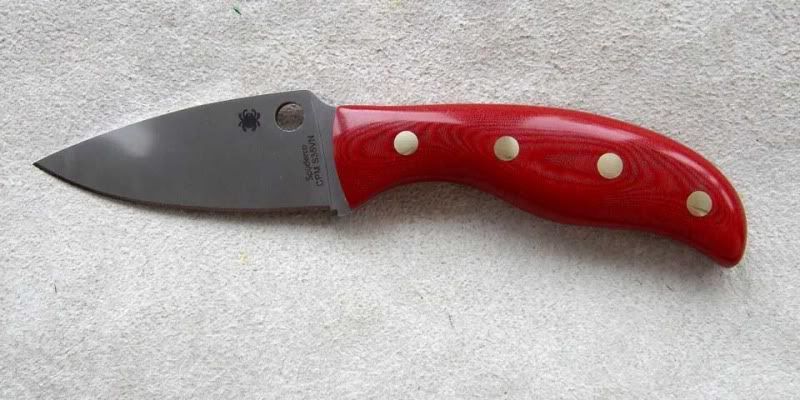
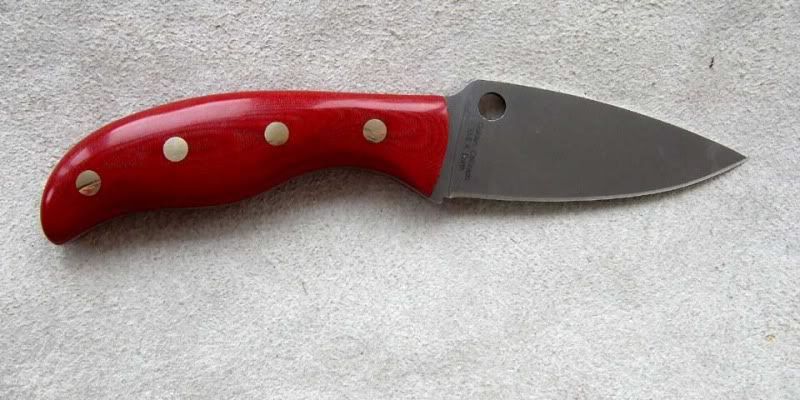
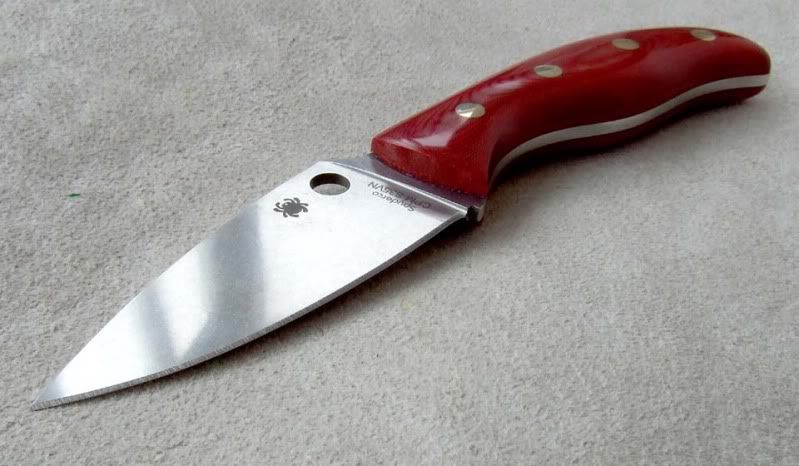
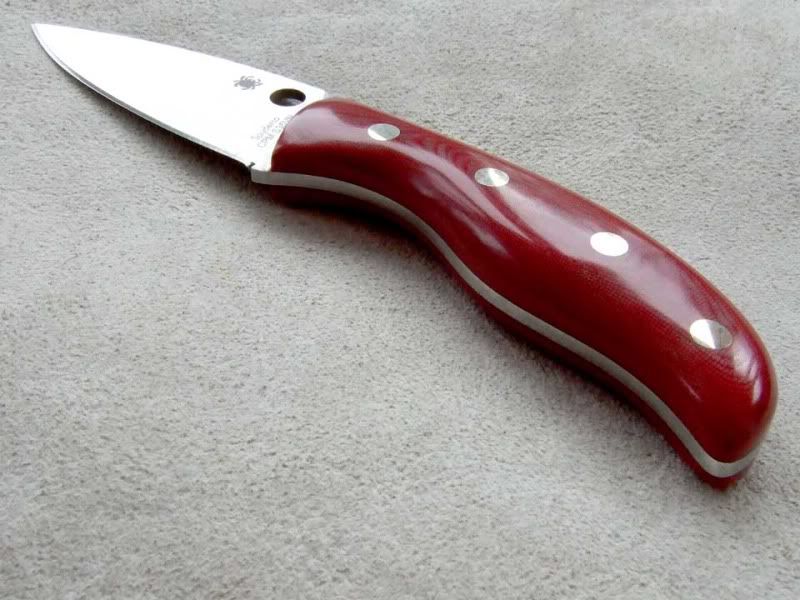
The other is a ZDP189 blade. Following reports of the exceptionally hard blade cracking/breaking, Spyderco announced an optional recall. Their initial plan was that the returned blades (unhandled) would be re-heat treated to a lower Rc (a mere 60-61!?) but subsequent analysis suggested the structure of the steel was at fault not the HT.
In view of the early reports of failures, I chucked on some ugly brown, linen micarta which was hanging around. I went a bit overboard on the rivets, in number and vigorousness of peening (you can see the damage to the micarta!) But this was a rush job for testing only. The blade didn't seem to mind me pounding away at those rivets. Not my best work!
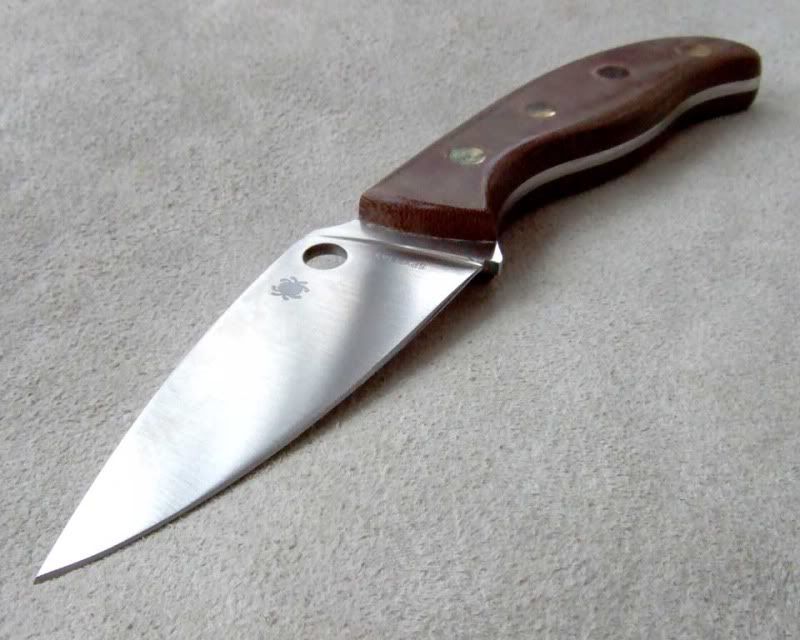
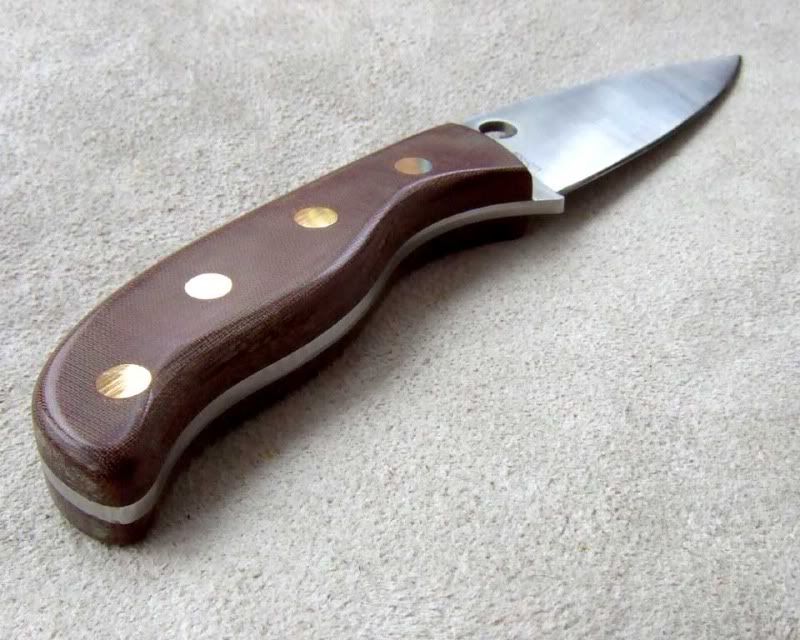
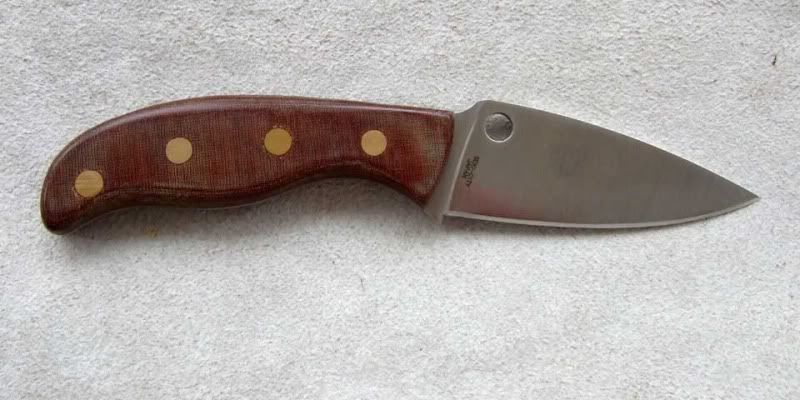
First, some wood:
Whittling an ash stave for a carving horse:
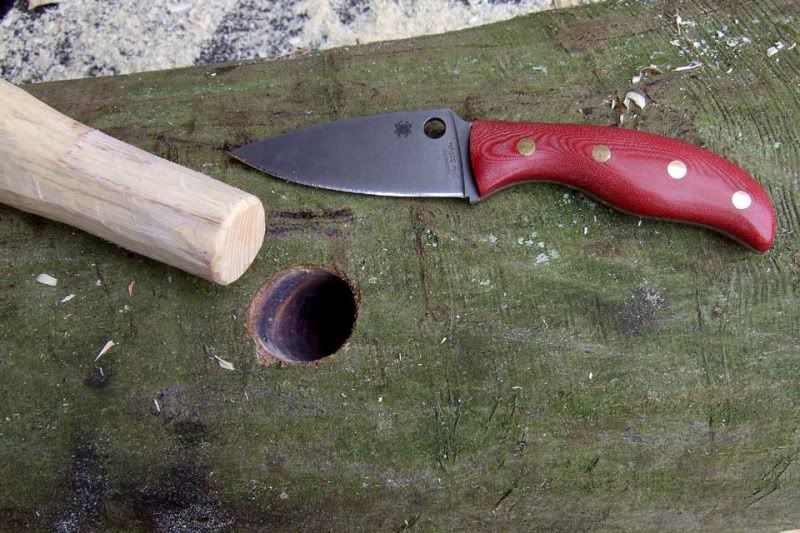
Feather (fuzz) sticks:
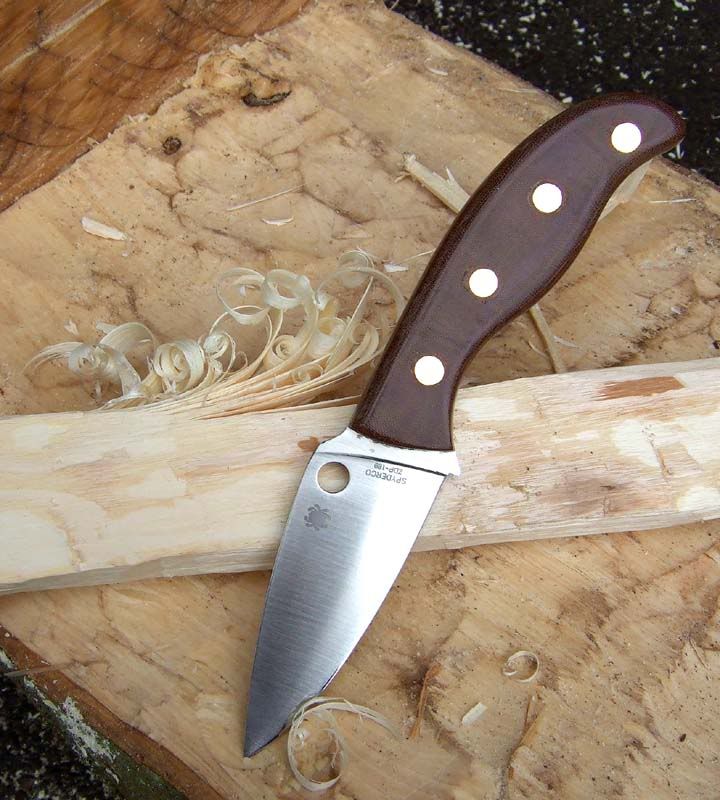
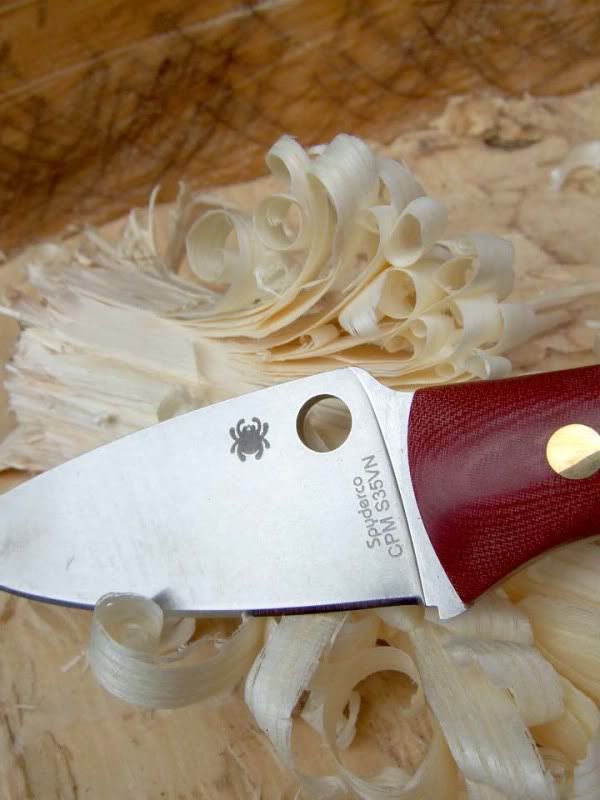
I found the CPM-S35v better for feather sticks. I suspect this is simply because I felt enough confidence in the steel to apply more lateral force, allowing tighter, thinner curls. I was probably subconsciously aware that the allegedly very brittle ZDP189 might not like this treatment, hence the fat slithers with poor curling (where I have angled the blade to get the bite, instead of pressing the edge into the wood.)
Food prep: The blade shape and edge excel at food prep so long as the guard is shortened (it still impinges on the cutting board in some situations):
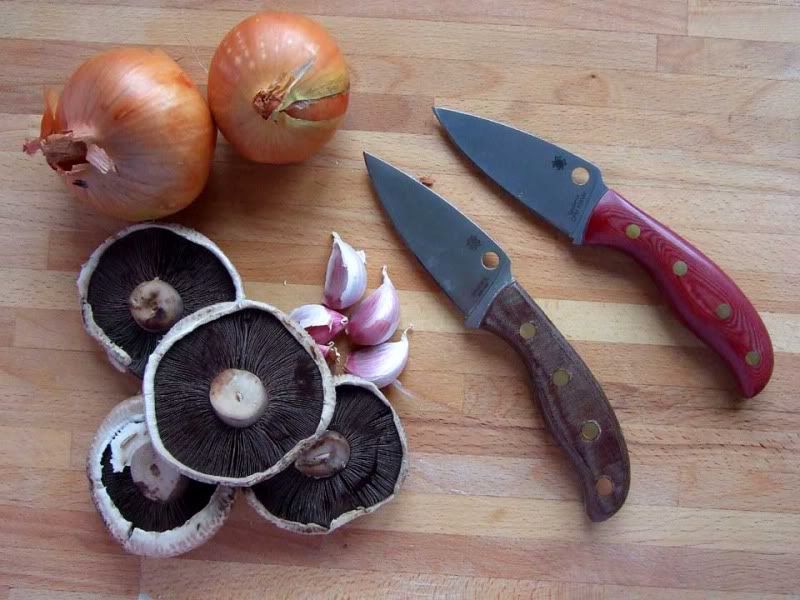
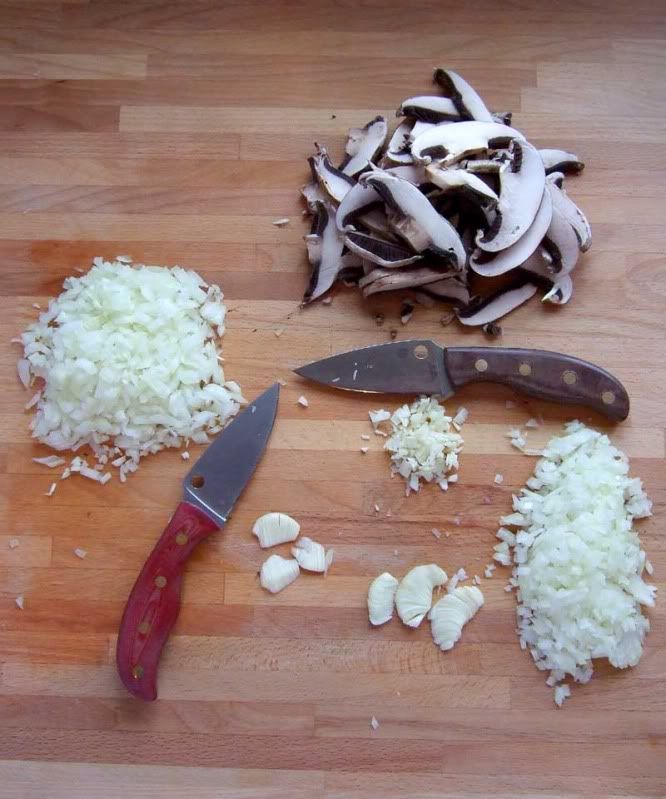
Hunting: Venison
WARNING: Gory pics below-Beware! Do not scroll down if you are distressed by images of blood/dead animals, etc...
Two fallow does, post gralloch:

The blade shape was fine for the somewhat fiddly release of the rectum and vagina from the pelvic walls. I didn't notice any blunting by the end of my thrid deer that day (3rd deer not shown):
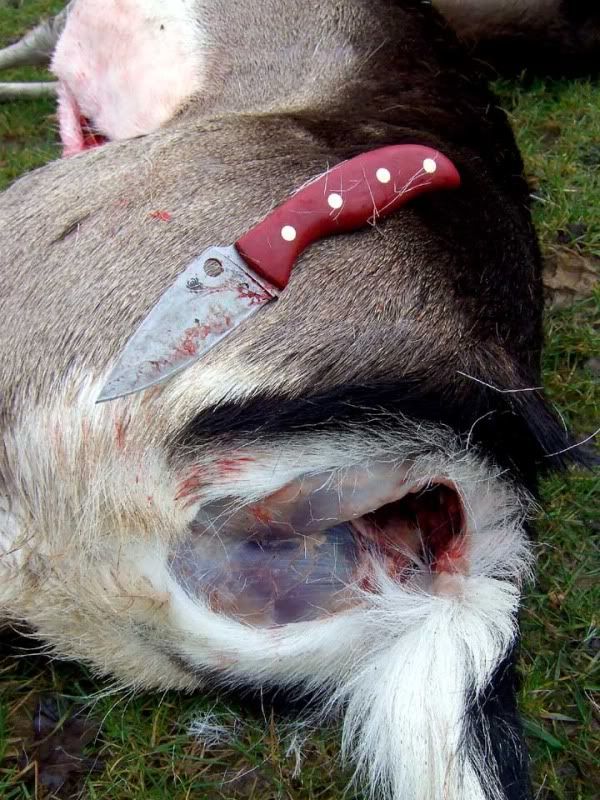
Popping open the atlanto-occipital joints to get the head off.

Taking the legs off is a good test of tip and edge strength, as well as edge-holding: cutting onto bone and sticking the tip into the joint to cut the capsule and ligaments asks a lot of the blade. The more observant of you will have noticed there are lots of front legs, few back legs and some Roe deer legs in amongst the fallow (I had a total of three deer to process):

Retrieving a bullet that had not exited (I homeload and I like to know the retained mass to tie in with the post-mortem findings and help improve the terminal ballistic performance of my rounds) The knife was still sharp enough to cut through the hair and skin over the bullet.

The pluck showing high heart and lung shot:

Pre-skinning:
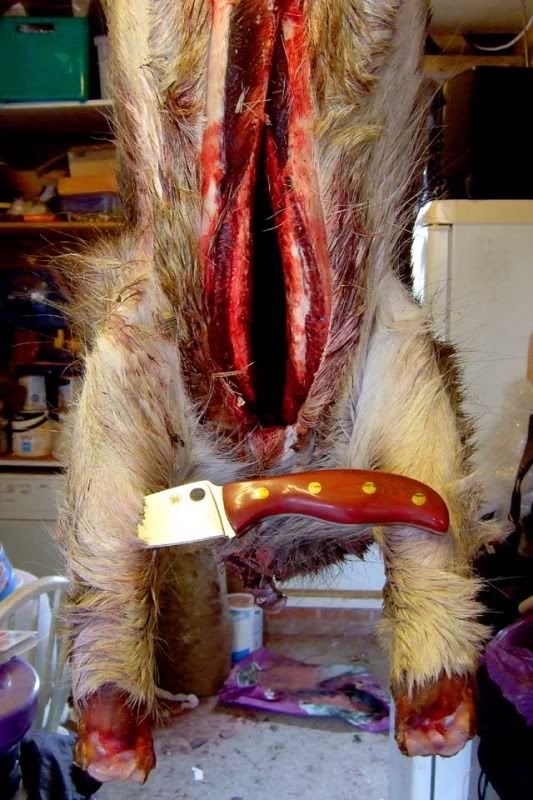
Post skinning/pre-butchering:
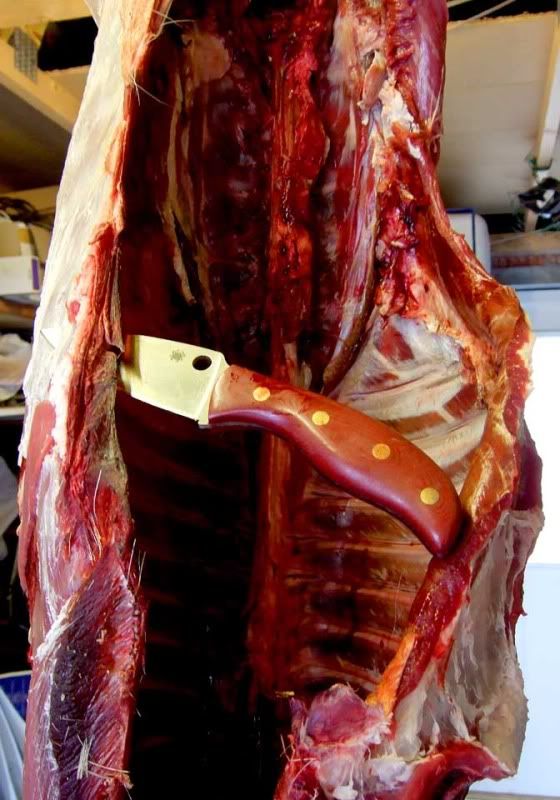
Meanwhile, back at the ranch...
A heavily pregnant mare had jumped into her manger (mad animal!). The girls who run the livery were reluctant to get her to jump out in case she hurt herself. We ended up taking one end of the manger off. This required abuse of lots of tools, including my mule. The heads of the coach bolts had been driven deep into the old railway sleepers and with the time, the wood had swelled, completely covering them. In order to get the impact driver on to the heads, I had to dig out the wood from around them. Inevitably, I ended up hitting the heads with the blade several times :C
Spot the spyderco:
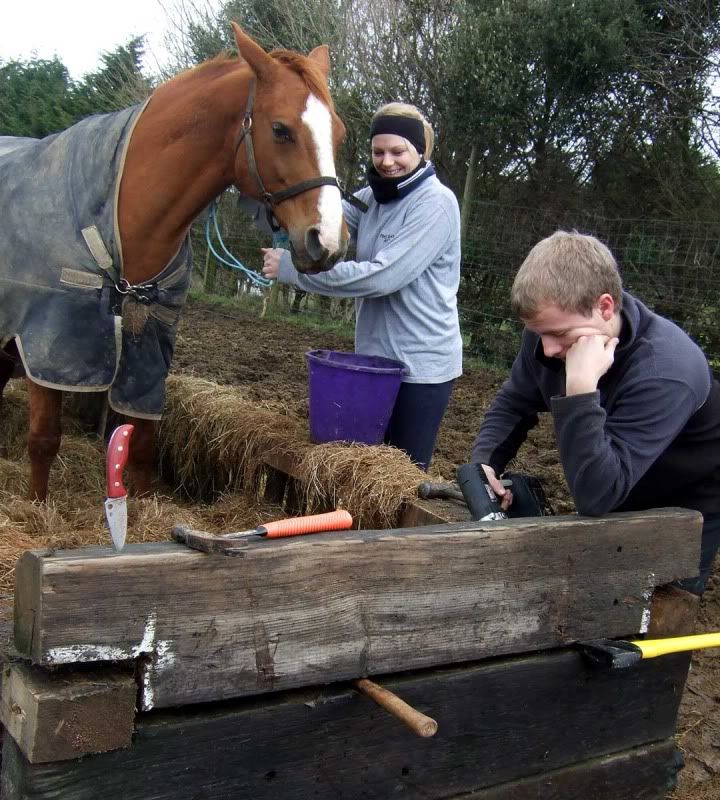
Edge damage from digging out wood from around buried coach-bolt; the edge at the tip has deformed a little with small chip only (quite impressive given the abuse sustained):
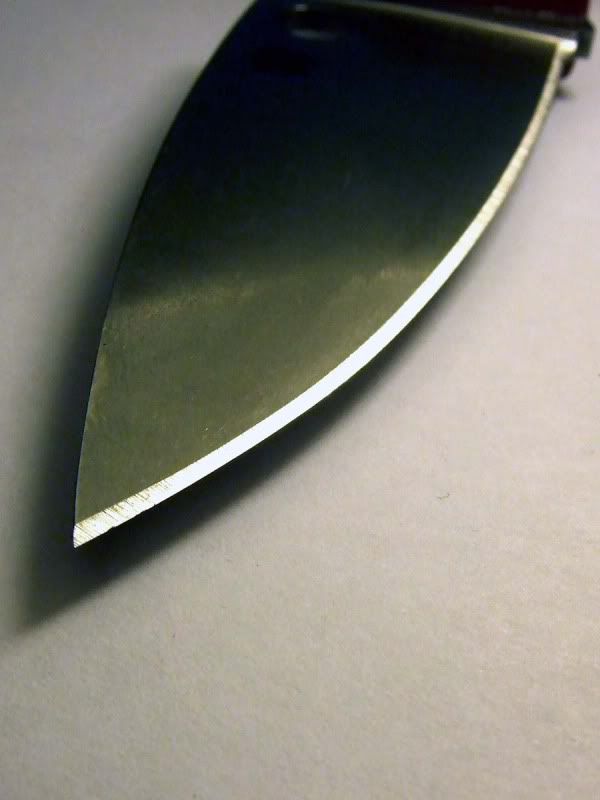
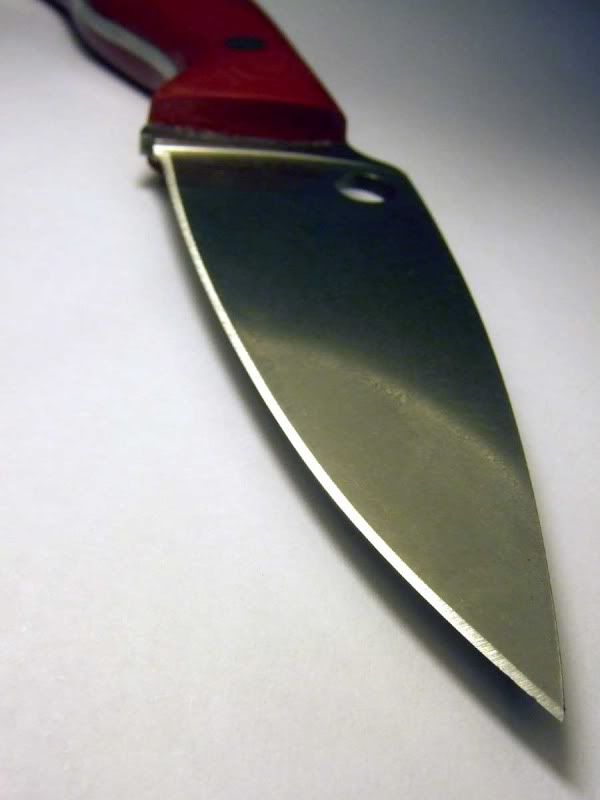
I used the knives for cutting some leather (3.5mm veg-tanned). I diced the off cuts, too, and then tested the blades on a piece of paper:

Interestingly, the ZDP was still able to slice curls from the edge (although not very fine curls) whereas the CPM-S35v could not (see top of the sheet in pic above), and tended to snag in simple drag cuts through paper.
Corrosion hasn't been a problem for either blade. I have had no difficulty sharpening with japanese water stones and ceramics. I had expected to need diamond stones for the ZDP189 in its ultra-hard state.
I have tried to balance the use of these two blades to allow a comparison of the steels. On the face of, the ZDP189 seems to exhibit better edge-holding, but in practice I think I worked the CPM-S35v harder, so it blunted more.
In summary:
I like the design of the mule blades, except for the prominent guard (not shown here as I had already ground it down.) I have not tried battoning and I doubt the depth of the blade would lend itself to finer whittling/carving where tight turns are required.
CPM-S35v, like it's S30v sibling, makes for a good blade steel. I suspect I'd be hard pushed to notice a difference between the two, though. It was sharpenable and held a good edge through a range of tasks.
ZDP-189: this test is not really a fair appraisal of ZDP's capabilities, due to the faulty batch (or whatever it was) of steel this knife was made from. My blade has not shown any cracking or chipping, despite moderate use. It lives in the kitchen, where it succeeds as a food prep knife. Time will tell how the steel holds up. I have other knives in ZDP (Stretch CF, Caly3 CF) which I like very much.
I look forward to the next Mule, whatever it turns out to be made of!
These were to be hard working knives, so I fitted linen micarta for my two mules. I also reshaped the guard as it is rather long. Both blades arrived very sharp.
CPM-S35v with red linen micarta.




The other is a ZDP189 blade. Following reports of the exceptionally hard blade cracking/breaking, Spyderco announced an optional recall. Their initial plan was that the returned blades (unhandled) would be re-heat treated to a lower Rc (a mere 60-61!?) but subsequent analysis suggested the structure of the steel was at fault not the HT.
In view of the early reports of failures, I chucked on some ugly brown, linen micarta which was hanging around. I went a bit overboard on the rivets, in number and vigorousness of peening (you can see the damage to the micarta!) But this was a rush job for testing only. The blade didn't seem to mind me pounding away at those rivets. Not my best work!



First, some wood:
Whittling an ash stave for a carving horse:

Feather (fuzz) sticks:


I found the CPM-S35v better for feather sticks. I suspect this is simply because I felt enough confidence in the steel to apply more lateral force, allowing tighter, thinner curls. I was probably subconsciously aware that the allegedly very brittle ZDP189 might not like this treatment, hence the fat slithers with poor curling (where I have angled the blade to get the bite, instead of pressing the edge into the wood.)
Food prep: The blade shape and edge excel at food prep so long as the guard is shortened (it still impinges on the cutting board in some situations):


Hunting: Venison

WARNING: Gory pics below-Beware! Do not scroll down if you are distressed by images of blood/dead animals, etc...
Two fallow does, post gralloch:

The blade shape was fine for the somewhat fiddly release of the rectum and vagina from the pelvic walls. I didn't notice any blunting by the end of my thrid deer that day (3rd deer not shown):

Popping open the atlanto-occipital joints to get the head off.

Taking the legs off is a good test of tip and edge strength, as well as edge-holding: cutting onto bone and sticking the tip into the joint to cut the capsule and ligaments asks a lot of the blade. The more observant of you will have noticed there are lots of front legs, few back legs and some Roe deer legs in amongst the fallow (I had a total of three deer to process):

Retrieving a bullet that had not exited (I homeload and I like to know the retained mass to tie in with the post-mortem findings and help improve the terminal ballistic performance of my rounds) The knife was still sharp enough to cut through the hair and skin over the bullet.

The pluck showing high heart and lung shot:

Pre-skinning:

Post skinning/pre-butchering:

Meanwhile, back at the ranch...
A heavily pregnant mare had jumped into her manger (mad animal!). The girls who run the livery were reluctant to get her to jump out in case she hurt herself. We ended up taking one end of the manger off. This required abuse of lots of tools, including my mule. The heads of the coach bolts had been driven deep into the old railway sleepers and with the time, the wood had swelled, completely covering them. In order to get the impact driver on to the heads, I had to dig out the wood from around them. Inevitably, I ended up hitting the heads with the blade several times :C
Spot the spyderco:

Edge damage from digging out wood from around buried coach-bolt; the edge at the tip has deformed a little with small chip only (quite impressive given the abuse sustained):


I used the knives for cutting some leather (3.5mm veg-tanned). I diced the off cuts, too, and then tested the blades on a piece of paper:

Interestingly, the ZDP was still able to slice curls from the edge (although not very fine curls) whereas the CPM-S35v could not (see top of the sheet in pic above), and tended to snag in simple drag cuts through paper.
Corrosion hasn't been a problem for either blade. I have had no difficulty sharpening with japanese water stones and ceramics. I had expected to need diamond stones for the ZDP189 in its ultra-hard state.
I have tried to balance the use of these two blades to allow a comparison of the steels. On the face of, the ZDP189 seems to exhibit better edge-holding, but in practice I think I worked the CPM-S35v harder, so it blunted more.
In summary:
I like the design of the mule blades, except for the prominent guard (not shown here as I had already ground it down.) I have not tried battoning and I doubt the depth of the blade would lend itself to finer whittling/carving where tight turns are required.
CPM-S35v, like it's S30v sibling, makes for a good blade steel. I suspect I'd be hard pushed to notice a difference between the two, though. It was sharpenable and held a good edge through a range of tasks.
ZDP-189: this test is not really a fair appraisal of ZDP's capabilities, due to the faulty batch (or whatever it was) of steel this knife was made from. My blade has not shown any cracking or chipping, despite moderate use. It lives in the kitchen, where it succeeds as a food prep knife. Time will tell how the steel holds up. I have other knives in ZDP (Stretch CF, Caly3 CF) which I like very much.
I look forward to the next Mule, whatever it turns out to be made of!
